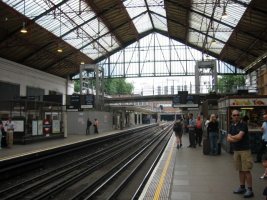 1973 Stock 126
1973 Stock 126
Arnos Grove Station, London, England
Operator of Vehicle: Transport for London
Date of Photo: May 21, 2008
This month, the London Transport Museum is celebrating the 90th anniversary of the Piccadilly Line extension to Cockfosters. In 1932, the line was extended from Finsbury Park to Arnos Grove. Then on March 13, 1933 the line was extended to Oakfields and again on July 31, 1933 to Cockfosters, which remains the terminal today. To mark this occasion, the London Transport Museum is running a special fantrip using its 1938 rolling stock on Sunday, July 9. I haven’t been in London when any of these special types of events put on my the museum have occurred, but from what I see on social media, they look to be great. As it is, the museum itself is a must see attraction for any transit fan visiting London.
The photo featured here is of the 1973 Stock that currently operates on the Piccadilly Line at the Arnos Grove station. The 1973 Stock is among the oldest rolling stock in use on a transit system in Britain but TfL has plans for new deep tube stock that may begin operating as soon as 2025.
For more photos of the 1973 Stock, please click here.
 1996 Tube Stock 96076
1996 Tube Stock 96076
 Planning a trip to London? Perhaps you are traveling to ride the
Planning a trip to London? Perhaps you are traveling to ride the 





